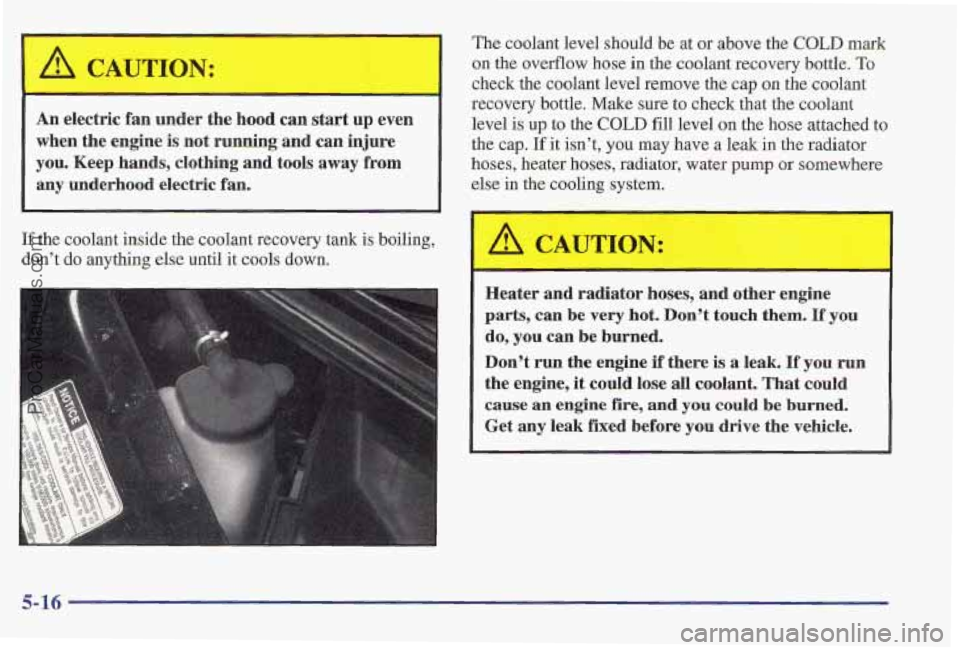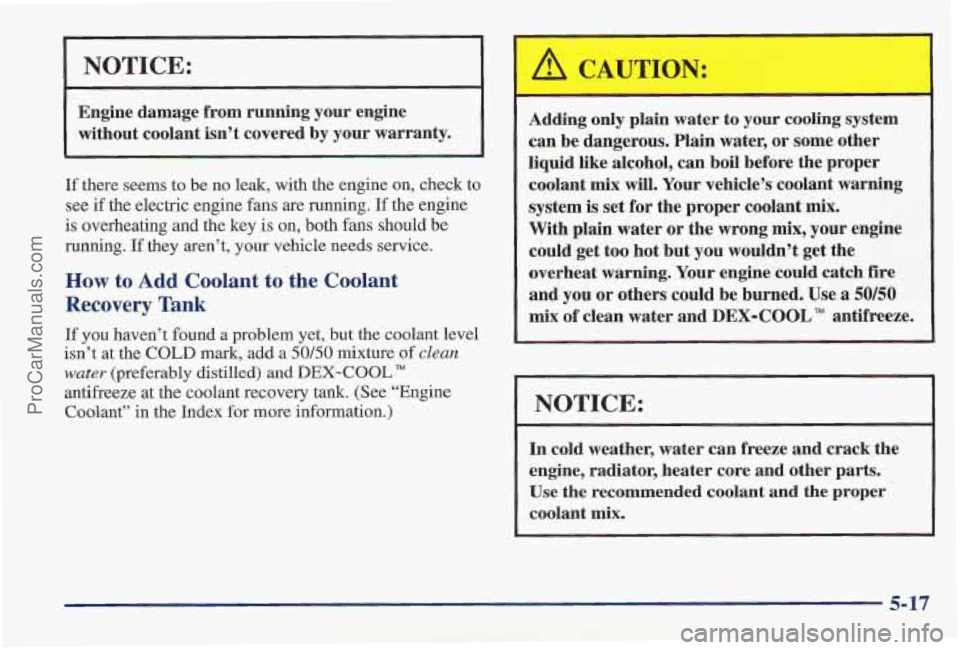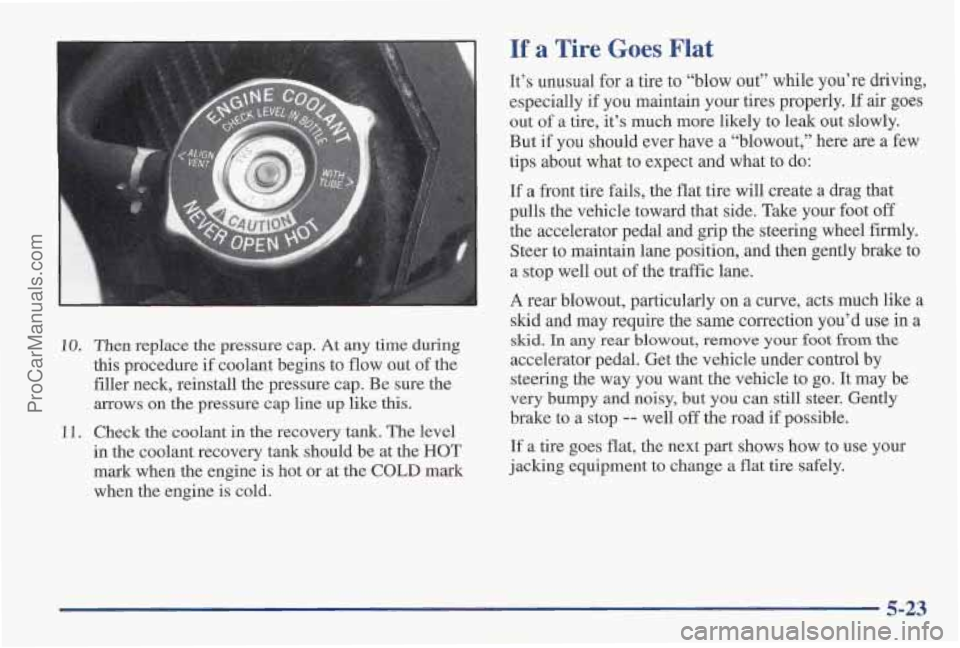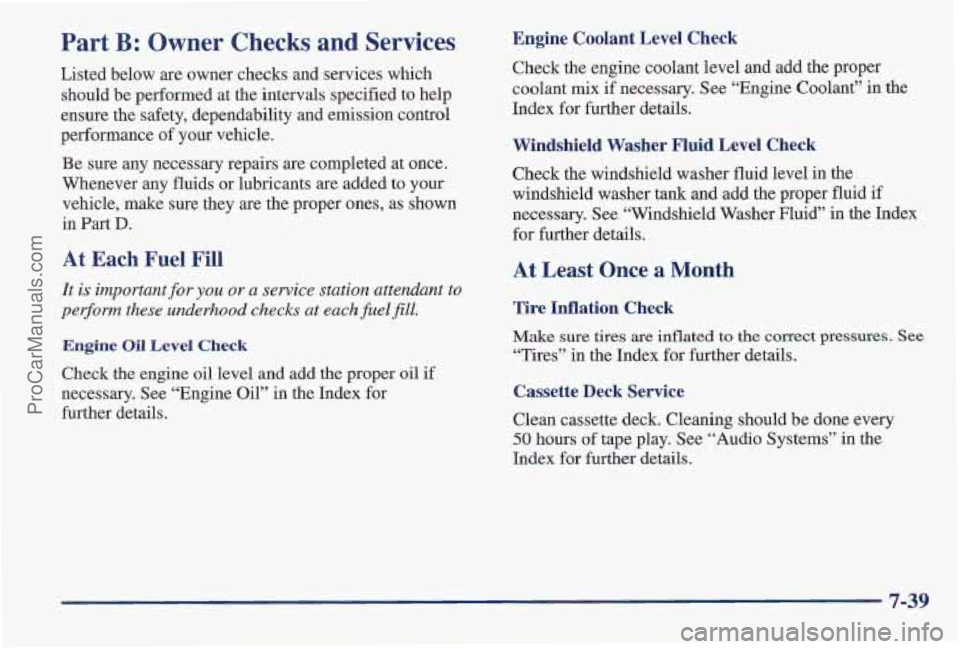Page 148 of 419

Low Oil Level Light
Your engine is equipped
with an oil level monitoring
system. When the ignition
key
is turned on, the LOW
OIL
LEVEL light will
briefly flash. If the light
does not flash, have it fixed
so it will be ready to warn
you if there’s
a problem.
Engine Coolant Temperature Light
TEMP
This light tells you that your
engine coolant has
overheated or your radiator
cooling fan is not working.
If the light stays on, stop th’e vehicle on a level surface
and
turn the engine off, Check the oil level using the
engine oil dipstick, (See “Engine Oil” in
the Index.)
The
oil level monitoring system only checks oil level
during the brief period between key ‘on and engine
crank. It
does not monitor engine oil level when the
engine
is running. Additionally, an oil level check is
only performed if the engine has been turned off for a
considerable period of time, allowing the oil normally in
circulation to drain back into the oil pan.
If you have been operating your vehicle under normal
driving conditions, you should pull
off the road, stop
your vehicle and turn
off the engine as soon as possible.
In “Problems on the Road,” this manual shows what to
do.
See “Engine Overheating” in the Index.
2-74
ProCarManuals.com
Page 250 of 419

I
An electric fan under the hood can start up even
when the engine is not running and can injure
you. Keep hands, clothing
and tools away from
any underhood electric fan.
If the coolant inside the coolant recovery tank is boiling,
don’t
do anything else until it cools down.
The coolant level should be at or above the COLD mark
on the overflow hose in the coolant recovery bottle. To
check the coolant level remove the cap on the coolant
recovery bottle. Make sure to check that the coolant
level is up to the
COLD fill level on the hose attached to
the cap.
If it isn’t, you may have a leak in the radiator
hoses, heater hoses, radiator, water
pump or somewhere
else in the cooling system.
Heater and radiator hoses, a i other engine
parts, can
be very hot. Don’t touch them. If you
do, you can be burned.
Don’t run the engine if there is a leak. If you run
the engine,
it could lose all coolant. That could
cause
an engine fire, and you could be burned.
Get any leak fixed before you drive the vehicle.
5-16
ProCarManuals.com
Page 251 of 419

NOTICE:
Engine damage from running your engine
without coolant isn’t covered
by your warranty.
_I
If there seems to be no leak, with the engine on, check to
see if the electric engine fans are running.
If the engine
is overheating and the key
is on, both fans should be
running. If they aren’t, your vehicle needs service.
How to Add Coolant to the Coolant
Recovery Tank
If you haven’t found a problem yet, but the coolant level
isn’t at the
COLD mark, add a 50/50 mixture of clean
water (preferably distilled) and DEX-COOL
antifreeze at the coolant recovery tank. (See “Engine
Coolant” in the Index for more information.)
Adding only plain water to your cooling system
can be dangerous. Plain water, or some other
liquid like alcohol, can boil before the proper
coolant mix will. Your vehicle’s coolant warning
system is set for the proper coolant
mix.
With plain water or the wrong mix, your engine
could get too hot but you wouldn’t get the
overheat warning. Your engine could catch
fire
and you or others could be burned. Use a 50/50
mix of clean water and DEX-COOL antifreeze.
I NOTICE:
In cold weather, water can freeze and crack the
engine, radiator, heater core and other parts.
Use the recommended coolant and the proper
coolant mix.
ProCarManuals.com
Page 256 of 419
6. Then fill the coolant recovery tank.
7. Put the cap back on the coolant recovery tank, but
leave the pressure cap
off.
8. Start the engine and let it run until you can feel the
upper radiator
hose getting hot. Watch out for the
engine fans,
9, By this time, the coolant level inside the radiator
filler
neck may be lower. If the level is lower, add
more
of the proper mix through the filler neck until
the level reaches the base of the filler neck.
5-22
ProCarManuals.com
Page 257 of 419

If a Tire Goes Flat
10. Then replace the pressure cap. At any time during
this procedure if coolant begins to flow out
of the
filler neck, reinstall the pressure cap. Be sure the
mows
on the pressure cap line up like this.
11. Check the coolant in the recovery tank. The level
in the coolant recovery tank should be at the HOT
mark when the engine is
hot or at the COLD mark
when the engine is cold. It’s unusual for
a tire to “blow out”
while you’re driving,
especially
if you maintain your tires properly. If air goes
out of a tire, it’s much more likely to leak out slowly.
But if you should ever have a “blowout,” here are a few
tips about what to expect and what to do:
If
a front tire fails, the flat tire will create a drag that
pulls the vehicle toward that side. Take your foot
off
the accelerator pedal and grip the steering wheel firmly.
Steer to maintain lane position, and then gently brake to
a stop well out
of the traffic lane.
A rear blowout, particularly on a curve, acts much like a
slud and may require the same correction you’d use in a
skid. In any rear blowout, remove your foot from the
accelerator pedal. Get the vehicle under control by
steering the way you want the vehicle to go. It may be
very bumpy and
noisy, but you can still steer. Gently
brake to a stop
-- well off the road if possible.
If a tire goes flat, the next part shows how to use your
jacking equipment to change a
flat tire safely.
ProCarManuals.com
Page 271 of 419

Section 6 Service and Appearance Care
Here you will find information about the care of your Pontiac. This section begins with service and fuel information,
and then it shows how to check important fluid and lubricant levels. There
is also technical information about your
vehicle, and a part devoted to its appearance care.
6-2
6-3 6-5
6-5
6-7
6- 14
6-2 1
6-26
6-32
6-33 6-36
6-37
6-37 6-44
6-46
Doing Your Own Service Work
What Kind of Fuel to Use
Using Fuel in Foreign Countries
Where to Put the Fuel and Filling the Tank
Checking
Things Under the Hood
Checking Your Engine Oil
Automatic Transaxle Fluid
Engine Coolant
Where to Fill the Windshield Washer Fluid
Important Brake Information
Information on Your Vehicle’s Battery
Tips on Vehicle Storage
Bulb Replacement Procedures
Windshield Wiper Blade Replacement
How and When to Check Tire Inflation 6-50
6-52
6-55
6-58
6-59
6-61
6-63
6-64
6-65 6-66
6-66
6-72
6-72
6-73
6-73 When
it is Time to Buy New Tires
Wheel Alignment
Cleaning the Inside of Your Vehicle
Care of the Safety Belts and Built-in
Child Restraint
Cleaning the Outside of Your Vehicle
How to Clean Aluminum Wheels
Underbody Maintenance
Recommended Appearance
Care Materials
Your Vehicle Identification Number (VIN)
The Electrical System
Fuses and Circuit Breakers
Replacement Bulb Types for Your Vehicle
Capacities and Specifications
Air Conditioning Specifications
Normal Replacement Parts
ProCarManuals.com
Page 298 of 419
Checking Coolant
When your engine is cold, the coolant level should be
at the COLD mark or a little higher. To check coolant
level, remove the cap on the coolant recovery bottle and
verify that
the coolant level is up to the COLD fill level
on the hose attached to the cap.
LOW
COOLANT
If this light comes on, it
means
you’re low on
engine coolant.
Adding Coolant
If you need more coolant, add the proper DEX-COOL”
coolant mixture at the mulant recovery tank.
If the coolant recovery tank is completely empty, add
coolant
to the radiator. (See “Engine Overheating” in
the
Index.)
6-28
ProCarManuals.com
Page 383 of 419

Part B: Owner Checks and Services
Listed below are owner checks and services which
should be performed at the intervals specified to help
ensure the safety, dependability and emission control
performance
of your vehicle.
Be sure any necessary repairs are completed at once.
Whenever any fluids or lubricants are added to your
vehicle, make sure they are the proper ones, as shown
in Part
D.
At Each Fuel Fill
It is important for you or a service station attendant to
perform these underhood checks at each fuel
fill.
Engine Oil Level Check
Check the engine oil level and add the proper oil if
necessary. See “Engine Oil” in the Index for
further details.
Engine Coolant Level Check
Check the engine coolant level and add the proper
coolant mix if necessary. See “Engine Coolant” in the
Index for further details.
Windshield Washer Fluid Level Check
Check the windshield washer fluid level in the windshield washer tank and add the proper fluid if
necessary. See “Windshield Washer Fluid” in
the Index
for further details.
At Least Once a Month
Tire Inflation Check
Make sure tires are inflated to the correct pressures. See
“Tires” in the Index for further details.
Cassette Deck Service
Clean cassette deck. Cleaning should be done every
50 hours of tape play. See “Audio Systems” in the
Index for further details.
7-39
ProCarManuals.com